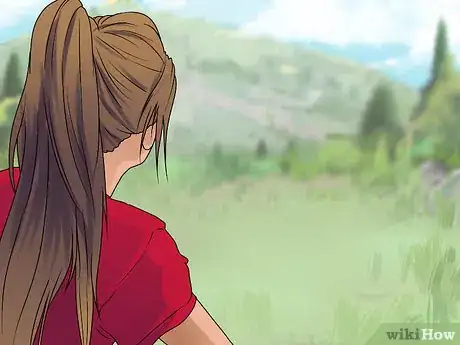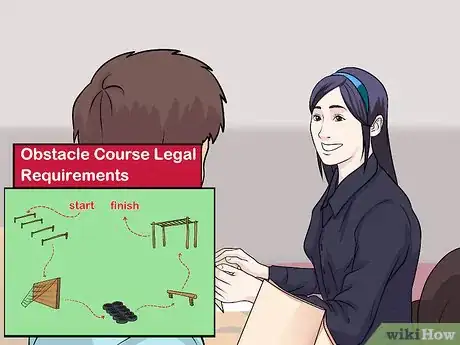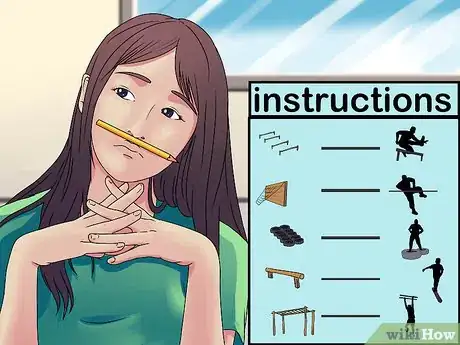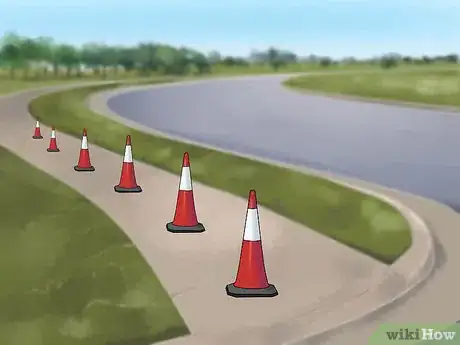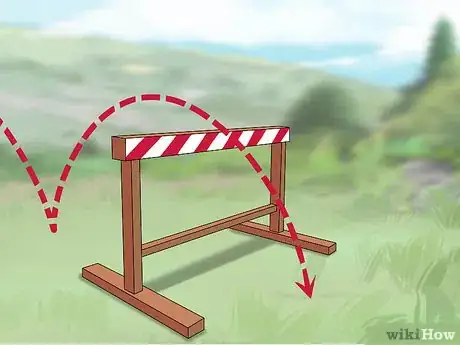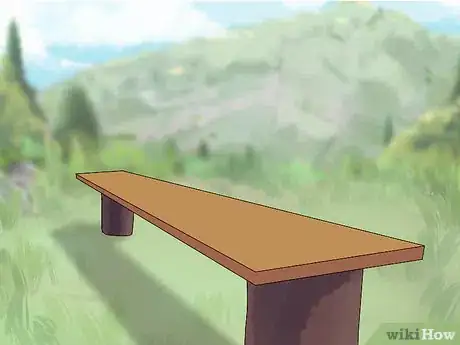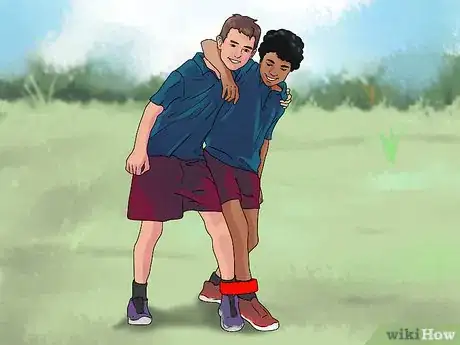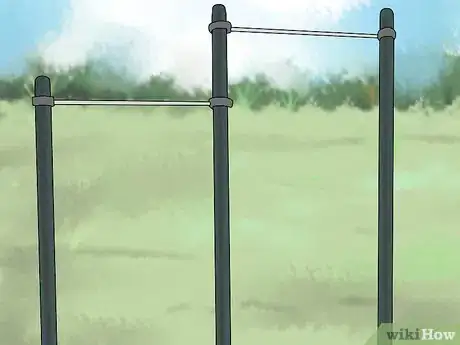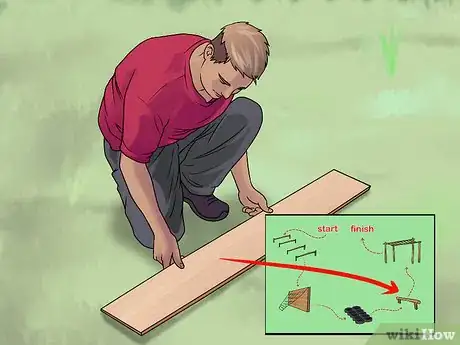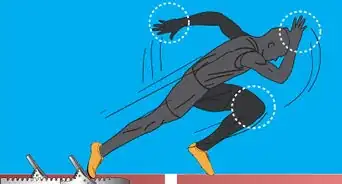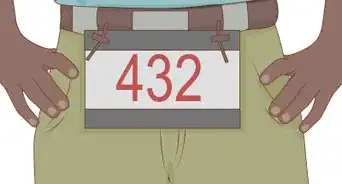This article was co-authored by Justin Conway. Justin Conway is an American Ninja Warrior competitor and the owner of World Ninja Sport, a ninja obstacle course company that provides obstacle design, construction, ninja coach certifications, and ninja curricula. With over seven years of experience, Justin specializes in helping gyms create and expand ninja programs along with certifying Ninja Warrior coaches. Justin holds a BS in Psychology from New York University, and he is the creator of the world’s first Ninja Coach Certification, SPOTTED. Justin is a founding member of Ninja USA and a founding board member of the National Ninja League. He is a three-time competitor and a six-time Las Vegas course tester for American Ninja Warrior. Justin is a certified level two parkour instructor and the host of the New York Ninja competition series.
wikiHow marks an article as reader-approved once it receives enough positive feedback. In this case, 89% of readers who voted found the article helpful, earning it our reader-approved status.
This article has been viewed 122,291 times.
Obstacle courses are a lot of fun to participate in and building them can be just as much fun. When building your obstacle course focus on keeping it balanced, including obstacles that present different challenges and that are also age appropriate. Whether creating an obstacle course for adults or children, having a good plan in place and knowing the basics can help you to create the best obstacle course possible.
Steps
Planning the Obstacle Course
-
1Find a good space for the obstacle course. Before you can begin planning the details of your obstacle course you will need to find a good location to build it in. The obstacles you can later include may be dictated by the location you choose, depending largely on the amount of space available and the terrain itself. Look around for the best space available to you for your obstacle course.
- Hills might be obstacles themselves and can add difficulty to your course.
- Flat areas are a great location if you plan on building obstacles yourself that need to be level.
- Bodies of water can be used as a fun swimming obstacle or something to jump over.
- Make sure your space has enough room for any obstacles you want to include.
- Check that the area is free from any hazards such as stones, hard surfaces, or anything else that could cause harm.
-
2Think about who will be using the obstacle course. Not all obstacle courses are created the same. You will need to build your course while keeping the participants in mind. Think about the age and physical fitness levels of those who will be using the course. Try to build a safe and challenging course based on this information.
- Children's obstacle courses should be simple and safe, avoiding any hard, large, or dangerous obstacles.
- Obstacle courses for adults can be more intensive and include more dangerous obstacles like swimming through a deep body of water.
Advertisement -
3Start planning out your obstacle course. Once you know where you are going to build your course and who is going to use it you can begin to plan your course. These details will allow you to think about which obstacles you might want to include, the level of difficulty, and safety issues in mind as you plan your course.
- Think about which obstacles would fit certain areas of your space better.
- Consider how the obstacles will work sequentially.
- Make sure obstacles are far enough apart so that they won't interfere with one another.
-
4Consider legal concerns. If your obstacle course is being planned for any kind of fund-raising, public, or any other community event you will need to plan and secure certain legal requirements. Building a simple obstacle course for your friends and family on the other hand will not require such steps. Make sure that your obstacle course is legally protected if need be before proceeding.
- Simple backyard obstacle courses won't need any legal protection.
- Larger, public and for-profit courses will need legal protection and other legal requirements.
- Legal requirements will vary greatly depending on location and event. Talk with a lawyer to learn more.
Creating Obstacles
-
1Think about instructions. Part of an obstacle course is having rules. If participants don't understand how to proceed when tackling an obstacle they may do so in an unfair or unsafe way. Think about some of the basic types of obstacles and how you might instruct participants when they encounter them.[1]
- Having instructions can help prevent injury and make a fair obstacle course.
- Include specific instructions on how an obstacle is to be completed.
- For example, participants must go through a tunnel and not over it.
-
2Include obstacles that test agility.[2] A common obstacle course element is to feature obstacles that test a person's agility. These obstacles will require a person to move quickly and accurately to successfully move past them. Create a well-rounded course by including obstacles that test agility. [3]
- Running around a series of cones, like a skier slaloming, can be a good test of agility.
- Try tying small threads with bells attached to them just off the ground. Participants have to step around them without ringing the bells.[4]
- Hanging hula-hoops from a branch can create an obstacle that needs to be hopped or stepped through.
-
3Create jumping obstacles. Many obstacle courses contain obstacles that require the participants to leap over or around. Including jumping obstacles can be a great way to make your obstacle course a fun challenge. Review some of the following ideas to get you started when thinking about your jumping obstacles:[5]
- Try setting some targets, such as a hula hoop, on the ground to have people jump towards.
- Consider a section of the course that has to be done on a pogo stick or bounce ball.
- Create a high jump obstacle by placing something soft in the path like a hay bale.
- Doing a series of frog jumps can be a good test of jumping abilities.
-
4Build a balancing obstacle for your course.[6] Balancing obstacles will test the fine movements of participants as they attempt the obstacle. These obstacles are generally slower paced, requiring graceful and thoughtful motions from those undertaking the obstacle course.[7]
- A simple straight board can make a good balance beam.
- You can require people to stand on one leg for a certain amount of time.
- Participants might be required to balance a ball on their head for a few seconds.
-
5Include teamwork in your obstacles. Although many obstacle courses are competitions between individuals, you may want to include obstacles that require teamwork. Including teamwork can be a great way to get your participants working together to overcome the obstacle course.
- Partners might have to throw and catch a ball a certain number of times.
- The three-legged race is a good obstacle that requires teamwork (When doing a three-legged race, be sure that the pairs ankles are touching and the rope used is tight around their ankles. Also, ensure that they put their arms around each other's waist for good support. (This obstacle is best completed in boy/girl pairs!).
- Having a “human wheelbarrow” section of the course can be a good way to include teamwork.
-
6Create obstacles that test strength.[8] Beyond challenging participants agility, speed, and balance your obstacles should also test strength. Many strength-based obstacles will require that some amount of weight be moved or lifted either over a distance or a certain number of times.[9]
- You might have a section where people have to do a certain amount of push-ups before continuing.
- Placing a simple pull up bar or arm hang bar can test upper body strength.
- Running while carrying something heavy can be a test of the whole body's strength.
- Crawling can engage the entire body.
Building The Obstacle Course
-
1Consider inflatable obstacles. A safe and easy option for creating an obstacle course is to make use of inflatable obstacles. Since these obstacles are inflatable they pose a low risk of injury and can add an appealing and lighthearted feeling to your obstacle course. Check your local businesses and services to see if any nearby vendors offer inflatable obstacles either for sale or rent.
- Most inflatable obstacles are designed with children in mind.
- Inflatable obstacles are easy to place, requiring little to no assembly.
-
2Gather materials. After you have your obstacles and their arrangement planned out you will need to acquire the materials that will be used to create the obstacles. The materials you need will vary greatly depending on what you have planned for your course. Look over some of the following ideas to get you started:
- Hula hoops can make great markers for jumping or agility obstacles.
- A simple board can make a quick balancing beam.
- Hay bales or couch cushions can make a fun jumping obstacle.
- Small sport cones can outline the obstacle course or be obstacles themselves.
-
3Place them according to plan. Having assembled your obstacles you can begin to place them according to your obstacle course layout plan. Place the obstacles where you planed them and evaluate their position before opening up our course to others.
- You might find that a planned location for an obstacle doesn't work well. Don't be afraid to make changes.
- Try doing the obstacle course yourself once you've built it to evaluate how well it works.
- Once you've built and tested your course it's time to open it up to others.
Expert Q&A
Did you know you can get expert answers for this article?
Unlock expert answers by supporting wikiHow
-
QuestionWhat are some good obstacles for fit adults?
 Justin ConwayJustin Conway is an American Ninja Warrior competitor and the owner of World Ninja Sport, a ninja obstacle course company that provides obstacle design, construction, ninja coach certifications, and ninja curricula. With over seven years of experience, Justin specializes in helping gyms create and expand ninja programs along with certifying Ninja Warrior coaches. Justin holds a BS in Psychology from New York University, and he is the creator of the world’s first Ninja Coach Certification, SPOTTED. Justin is a founding member of Ninja USA and a founding board member of the National Ninja League. He is a three-time competitor and a six-time Las Vegas course tester for American Ninja Warrior. Justin is a certified level two parkour instructor and the host of the New York Ninja competition series.
Justin ConwayJustin Conway is an American Ninja Warrior competitor and the owner of World Ninja Sport, a ninja obstacle course company that provides obstacle design, construction, ninja coach certifications, and ninja curricula. With over seven years of experience, Justin specializes in helping gyms create and expand ninja programs along with certifying Ninja Warrior coaches. Justin holds a BS in Psychology from New York University, and he is the creator of the world’s first Ninja Coach Certification, SPOTTED. Justin is a founding member of Ninja USA and a founding board member of the National Ninja League. He is a three-time competitor and a six-time Las Vegas course tester for American Ninja Warrior. Justin is a certified level two parkour instructor and the host of the New York Ninja competition series.
American Ninja Warrior Competitor & Consultant
-
QuestionThere are no flat places in my area, what do I do?
 Community AnswerGet creative with your environment. Incorporate trees and hills into the challenges.
Community AnswerGet creative with your environment. Incorporate trees and hills into the challenges. -
QuestionWhat if I have to do it indoors?
 Community AnswerObstacle courses are very versatile. You could have the course consist of going under chairs, stepping through rings, etc., just as easily indoors as outdoors.
Community AnswerObstacle courses are very versatile. You could have the course consist of going under chairs, stepping through rings, etc., just as easily indoors as outdoors.
Warnings
- Make sure your obstacles are as safe as can be.⧼thumbs_response⧽
- Build your obstacle course to an age-appropriate level.⧼thumbs_response⧽
- Always check that your obstacle course is as safe as possible before letting people run through it.[10]⧼thumbs_response⧽
- If your course involves jumping or climbing, place padding underneath the obstacle to prevent fall injuries.[11]⧼thumbs_response⧽
Things You'll Need
- A space to build the course.
- A plan for the course.
- Things to make the obstacles with.
References
- ↑ http://imaginationsoup.net/2011/04/a-backyard-obstacle-course-for-your-kids/
- ↑ Justin Conway. American Ninja Warrior Competitor & Consultant. Expert Interview. 15 September 2020.
- ↑ http://www.health.com/health/article/0,,20411950,00.html
- ↑ https://www.care.com/a/7-obstacle-course-ideas-for-kids-of-all-ages-20150706035417
- ↑ http://www.health.com/health/article/0,,20411950,00.html
- ↑ Justin Conway. American Ninja Warrior Competitor & Consultant. Expert Interview. 15 September 2020.
- ↑ http://ahealthieryou.meijer.com/10-easy-ideas-for-a-backyard-obstacle-course/
- ↑ Justin Conway. American Ninja Warrior Competitor & Consultant. Expert Interview. 15 September 2020.
- ↑ http://ahealthieryou.meijer.com/10-easy-ideas-for-a-backyard-obstacle-course/
About This Article
You can build your own fun obstacle course with some basic sports equipment. Have a simple sprint section, then a series of cones to run around like a slalom. Another section can be a jumping obstacle, like hurdles, hula hoops you have to jump between, or a high jump. You can also have a balancing obstacle like a straight board or an acrobatic beam. Alternatively, have people balance an object on a spoon for a short stretch. Inflatable obstacles are great for children too. You can set up your course in whichever order you like, but order it so similar obstacles aren’t next to each other to keep people on their toes. For more tips, including how to include team-based obstacles, read on!
